Ann Pancake’s collection of novellas and short stories, is steeped in the culture and dialect of generations of rural West Virginians; moreover, it’s awash with heartache, brutal honesty, mistrust of strangers, and the necessary and stubborn resolve that illuminates the mountain-state people’s passion for family and the place they call home. Continue reading “Me and My Daddy Listen to Bob Marley”
NewPages Blog
At the NewPages Blog readers and writers can catch up with their favorite literary and alternative magazines, independent and university presses, creative writing programs, and writing and literary events. Find new books, new issue announcements, contest winners, and so much more!
A Sunny Place with Adequate Water
Mary Biddinger’s fourth poetry collection, A Sunny Place with Adequate Water, grapples with social mores, loneliness, and isolation through serial non-sequitors and questions that seem sincerely non-rhetorical, yet go unanswered. Tonally, A Sunny Place with Adequate Water is reminiscent of the poetry of Mary Ruefle, or of Steven Millhauser’s prose poem novella, Enchanted Night. Continue reading “A Sunny Place with Adequate Water”
Spread the word!
Universe
Diana Hamilton’s Universe is one of the tightest projects I’ve ever read: a chapbook length poem on ethics, broken into two sections (one roughly on property/possession, the other on race) and comprised largely of analytical propositions angularly cut into strikingly short lines. “You and I exist in a civil condition” the speaker asserts. Doesn’t sound very exciting, does it? Continue reading “Universe”
Spread the word!
No Girls No Telephones
It’s funny to think of No Girls, No Telephones in the context of the fan genre, like everyone’s favorite 50 Shades of Gray, but let’s do that for just one wincingly good second. Okay. Of course, this isn’t 50 Shades of Gray. This is poetry, for one. It’s a collaboration between Brittany Cavallaro and Rebecca Hazelton, two talented and accomplished poets. And perhaps most importantly, it riffs not off of a tweeny bestseller but one of the most sophisticated, startling, and idiomatic literary works of the American tradition, John Berryman’s Dream Songs. Continue reading “No Girls No Telephones”
Spread the word!
Good Night Brother
Every line, phrase, and syllable of Kimberly Burwick’s Good Night Brother is thick with a language that perhaps only angels know. As I read these dense, imagistic lines, I recall the charismatic churches of my youth when, at Sunday morning worship, any number of individuals might erupt into an otherworldly song in “tongues,” coming from the spirit within. Perhaps Burwick has such a spirit—a poetic spirit that transforms “milkweed,” “geese,” “pheasants,” “berries,” “roads,” and “flies” into abstractions, the reader reveling in the feel of this strange language passing over the pores of the page. Continue reading “Good Night Brother”
Spread the word!
Un-Sight/ Un-Sound (delirium X.)
Un-Sight/ Un-Sound (delirium X.) is published by gnOme press, which specializes in anonymous, pseudepigraphical and apocryphal works; a press that also eliminates the name of the author because “The self in no way matters . . . (the reader) is any one and I (the author) am also anyone. . . .” The author, represented by the initial M, has written a text in three parts, each part its own distinct structure of fragments, each of the structures with its own specific effect. Across all three parts, the fragments of syntax elements yield each part’s content. This is not a theoretical exercise, but a language born of the body, the senses, the gut. . . born of the anguish and power of flesh in the world. Continue reading “Un-Sight/ Un-Sound (delirium X.)”
Spread the word!
The Original Folk and Fairy Tales of the Brothers Grimm
Along with Shakespeare, Tolstoy, Twain, and Anonymous, the authors of this anthology are among the most recognized in literature. Jacob and Wilhelm Grimm were also preservationists, transcribing fairy tales verbally passed down from generation to the next. With book in hand—something increasingly common during the course of the nineteenth century—the “Story Teller” no longer had to rely on memory. Since their publication in 1812, these stories found their way into other narrative forms including visual and/or animated art, music, opera, ballet, and film. Artists from Walter Crane to children sitting at the kitchen table have drawn Rumpelstiltskin, Snow White, and Rapunzel. Continue reading “The Original Folk and Fairy Tales of the Brothers Grimm”
Spread the word!
The Year of Perfect Happiness
In The Year of Perfect Happiness, nobody is perfect. Under a veneer of normalcy and seeming perfection lie malice, cunning, chicanery, and evil. In people like you and me that populate the landscape of Middle America—the ones with dreams and aspirations to have good jobs, a family, career and friends—have a little malice in us. Characters in Becky Adnot-Haynes’s The Year of Perfect Happiness, a collection of ten short stories, are etched with the slightest of kinks, of imperfections, that allow the evil to seep through, making the ordinary seem that much less so. Female protagonists are drawn with an eye towards the slightly weird, the eccentric, with tinges of idiotic. The characters stay with you long after you’ve flipped the page. Continue reading “The Year of Perfect Happiness”
Spread the word!
One Day I’ll Tell You the Things I’ve Seen
The characters in Santiago Vaquera-Vasquez’s stories navigate many worlds, literally and figuratively traversing continents, global metropolises, national borders, and epistemic boundaries, all in a quest for that universal human need for belonging and connectedness. In a collection of fourteen stories, Vaquera-Vasquez, an assistant professor in the Department of Spanish and Portuguese at the University of New Mexico, draws the blinds into a sub-culture of Eses, hombres, border crossers, and all things Chicano. Continue reading “One Day I’ll Tell You the Things I’ve Seen”
Spread the word!
Résumé
In the dedication Chris Green states that there is “no straightforward compensation.” The rest of the poems follow Joseph Brodsky’s quote during his employment trial, “Everything was interesting to me. I changed jobs because I wanted to learn more about life, about people.” There is a Midwestern, blue collar motif to the language that runs through the poems. There is plenty of indirect and direct evidence of the observations of a poet from Chicago. Many times I thought of Nickel and Dimed, Barbara Ehrenreich’s exposé on living a low-wage lifestyle. Continue reading “Résumé”
Spread the word!
The Word Kingdom in the Word Kingdom
This is not a pipe. The word is not the thing. The Word Kingdom in the Word Kingdom shares this sentiment. Noah Eli Gordon presents a modern treason of symbol. His words take flight in the very airplanes he describes. The trajectory is set by meta ontology. As the poems move forward and take shape, there is the sense that a message was thought of before the descriptions, that the writing has an agenda. However, there is a playful sense of tumbling through, that the words are allowing each other to create the next one. The message of origins of language and the etymology of our very ideas are shrouded in mystery. Continue reading “The Word Kingdom in the Word Kingdom”
Spread the word!
Glimmer Train December Fiction Open Winners :: 2015
Glimmer Train has just chosen the winning stories for their December Fiction Open competition. This competition is held twice a year. Stories generally range from 2000-6000 words, though up to 20,000 is fine. The next Fiction Open will take place in June. Glimmer Train’s monthly submission calendar may be viewed here.
 First place: Zeynep Ozakat of Istanbul, Turkey, wins $2500 for “Moving from Istanbul.” Her story will be published in Issue 96 of Glimmer Train Stories. This will be her first published story. [Photo credit: David Samuel]
First place: Zeynep Ozakat of Istanbul, Turkey, wins $2500 for “Moving from Istanbul.” Her story will be published in Issue 96 of Glimmer Train Stories. This will be her first published story. [Photo credit: David Samuel]
Second place: David Szucs of New York, NY, wins $1000 for “Rhubarb and Pussy Willow.”
Third place: Jonathan Frith of Cold Spring, NY, wins $600 for “Meese’s Father.”
A PDF of the Top 25 winners can be found here.
Deadline TODAY for the Short Story Award for New Writers: February 28. This competition is held quarterly and is open to all writers whose fiction has not appeared in a print publication with a circulation over 5000. No theme restrictions. Most submissions to this category run 1500-5000 words, but can go up to 12,000. First place prize is $1500. Second/third: $500/$300. Click here for complete guidelines.
Spread the word!
Fulton Prize for Fiction Winners
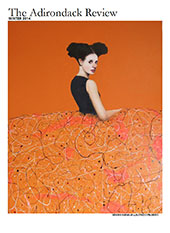 The Winter 21014 issue of Adirondack Review features the winner and runner-up of their annual Fulton Prize for Short Fiction. Winner “Study of an Orange” by Theresa Duve Morales receives $400 and publication and “Embryology” by Barrett Bowlin wins $30 and publication. The issue also features some marvelous artwork by Alfredo Palmero, Oscar Varona, Federico Federici, Stephen Nelson, and Sandrine Pagnoux. All worth the click.
The Winter 21014 issue of Adirondack Review features the winner and runner-up of their annual Fulton Prize for Short Fiction. Winner “Study of an Orange” by Theresa Duve Morales receives $400 and publication and “Embryology” by Barrett Bowlin wins $30 and publication. The issue also features some marvelous artwork by Alfredo Palmero, Oscar Varona, Federico Federici, Stephen Nelson, and Sandrine Pagnoux. All worth the click.
Spread the word!
Some Literary News Links :: February 2015
Ten Reasons to Write Short Stories Even Though the Pay is Peanuts – although one of the reasons is short stories can make money, there are several other more altruistic reasons as well.
Chrislove examines LGBT character visiblity in comic books and graphic novels – and offers loads of resources.
Just for fun: 6 Classic Novels That Could Use a Sequel – ETonline provides their opinion on what the sequel would include.
“Twitter’s not literature, but it can be a novel teaching tool” poses Harriet Line in the Times Higher Education.
From one literary lover to another, homeless man given a Kindle by a kind-hearted stranger.
The Bronte sisters’ family dining table has been saved from auction with the help of the Bronte Society and its supporters.
Jacqueline Sahagian offers 10 Better Books by the Authors you Read in School – good for starting a healthy literary argument!
Gender gaps in journalism classes and newsroom concern students.
Let’s get together, yeh-yeh-yeh: We need more STEM majors with liberal arts training.
Spread the word!
Poetry Northwest Honors Carolyn Kizer
 Poetry Northwest Winter & Spring 2015 issue is the first since founding editor Carolyn Kizer passed away October 9, 2014. The issue honors Kizer’s vision and legacy, as Editor Keven Craft writes in his introduction, in that “the majority of the poets in this issue are women. The majority of men herein write about (or through) a particular she. Or contend with otherness in other forms.” The publication is entirely devoted to poetry, “including a substantial section of poetry in translation, reflecting an important part of Kizer’s early attempts to internationalize Poetry Northwest.”
Poetry Northwest Winter & Spring 2015 issue is the first since founding editor Carolyn Kizer passed away October 9, 2014. The issue honors Kizer’s vision and legacy, as Editor Keven Craft writes in his introduction, in that “the majority of the poets in this issue are women. The majority of men herein write about (or through) a particular she. Or contend with otherness in other forms.” The publication is entirely devoted to poetry, “including a substantial section of poetry in translation, reflecting an important part of Kizer’s early attempts to internationalize Poetry Northwest.”
Spread the word!
Writer Beware Recent Posts
Some of the recent posts on Writer Beware: The Blog:
Two Red-Flag Sentences in Publishing Contracts
Lost in Translation (About the reputation of Author Translation service – worth reading the exchange!)
Who’s Running Your Writers’ Group? Why You Should Be Careful
Editing Clauses in Publishing Contracts: How to Protect Yourself
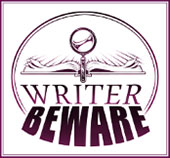 Writer Beware: The Blog is sponsored by Science Fiction and Fantasy Writers of America, with additional support from several other organizations. With author Victoria Strauss at the helm, their effort is “Shining a bright light into the dark corners of the shadow-world of literary scams, schemes, and pitfalls. Also providing advice for writers, industry news and commentary, and a focus on the weird and wacky things that happen at the fringes of the publishing world.”
Writer Beware: The Blog is sponsored by Science Fiction and Fantasy Writers of America, with additional support from several other organizations. With author Victoria Strauss at the helm, their effort is “Shining a bright light into the dark corners of the shadow-world of literary scams, schemes, and pitfalls. Also providing advice for writers, industry news and commentary, and a focus on the weird and wacky things that happen at the fringes of the publishing world.”
Spread the word!
Poetry :: Kimberly Reyes
Excerpt from “Undertones” by Kimberly Reyes published in The Acentos Review February 2015:
. . .
 The machete sugarcane bled
The machete sugarcane bled
Red on the island
dark and Jíbaro, Salinas poor,
Red was the language we spoke,
fertile in storied humility.
The good Red on the Mainland,
the mixed and other and ancient and othered,
rich ‘got some Indian in me’ reigning Red
whose scorn I
I didn’t know then.
my mutilated being
my maternal brown stain
The:
“why is your last name Reyes?”
“is your husband Spanish?”
This.
. . .
Read the full poem here.
Spread the word!
Iron Horse Takes on 50 Shades
This issue (17.1) 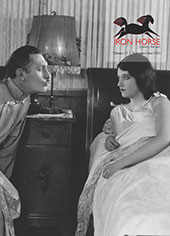 of Iron Horse Review had me at the cover image, which drew me in to learn this is the “Bedroom Issue.” Certainly not limited to that literal room, Assistant Editor Katie Cortese writes, “We considered this issue a risk.” Oh goodie! She goes on, “Not because sex is a taboo topic—as an important part of adult existence, it’s as worthy of ink and metaphor as any other aspect of living—but because writing about it is so hard to do well.”
of Iron Horse Review had me at the cover image, which drew me in to learn this is the “Bedroom Issue.” Certainly not limited to that literal room, Assistant Editor Katie Cortese writes, “We considered this issue a risk.” Oh goodie! She goes on, “Not because sex is a taboo topic—as an important part of adult existence, it’s as worthy of ink and metaphor as any other aspect of living—but because writing about it is so hard to do well.”
Cortese offers her view on the ends of the spectrum, from bad to good sex writing, and on purposely having released this issue for the movie release of Fifty Shades of Grey: “. . . we conceived this issue in part to combat some of the problems we see with a work like Fifty Shades of Grey. We don’t believe that series constitutes art.”
She goes on, engaging the perspective of Elizabeth Benedict in her work The Joy of Writing Sex to support what is “good” sex scene writing. “When we applied her standards to the wonderful, brave, inventive work that flooded our submission portal, we were forced to make some truly difficult decisions.”
Read Cortese’s full commentary here.
Spread the word!
Novel Studies Blog Seeks Contributors
 Studies in the Novel, a scholarly journal in its 47th year, invites submissions of guest blog posts and teaching resources to be considered as content on their newly-launched website. For the blog forum, the editors welcome incisive, humorous, and intellectually speculative posts from the journal’s readers, contributors, and the novel-loving community at large on issues of relevance to scholarship on the novel, new and noteworthy novels, or other novel topics. The selection and publication of blog posts will be at the discretion of the editor and the Studies in the Novel editorial advisory board. This intellectual forum extends the journal’s mission by publicizing new directions in the scholarship and teaching of novels and by promoting intellectual exchange. Visit their website for more information.
Studies in the Novel, a scholarly journal in its 47th year, invites submissions of guest blog posts and teaching resources to be considered as content on their newly-launched website. For the blog forum, the editors welcome incisive, humorous, and intellectually speculative posts from the journal’s readers, contributors, and the novel-loving community at large on issues of relevance to scholarship on the novel, new and noteworthy novels, or other novel topics. The selection and publication of blog posts will be at the discretion of the editor and the Studies in the Novel editorial advisory board. This intellectual forum extends the journal’s mission by publicizing new directions in the scholarship and teaching of novels and by promoting intellectual exchange. Visit their website for more information.
Spread the word!
Dis- Phoebe’s Poetry Special Feature
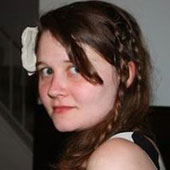 Issue 44.1 of George Mason University’s MFA-student-run Phoebe includes a special feature Poetry Editor Elizabeth Deanna Morris Lakes first starting mulling over as “disparity.”
Issue 44.1 of George Mason University’s MFA-student-run Phoebe includes a special feature Poetry Editor Elizabeth Deanna Morris Lakes first starting mulling over as “disparity.”
She writes, “So many of the struggles in my life and the lives of people I see in the world seem to revolve around some sort of disparity: of place, of mind, of circumstance. After speaking with Qinglan Wang, my assistant editor, I realized I was less interested in the ‘parity’ and more interested in the ‘dis-‘ – in poems that explored disability, in poems that confronted things that dissatisfied or disappointed, and in poems that grappled with disaster.”
Authors contributing to this special dis- poetry feature include Catherine Pierce, Stacey Kidd, Richard Greenfield, Dorothea Lasky, Matt Bell, Martha Collins, and Adam Clay.
Spread the word!
American Tanka: An Inch of Freedom
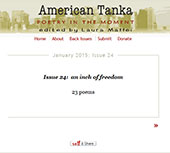 The newest issues (January 2015) of Ameican Tanka is themed “an inch of freedom.” A sampling of first lines: “from my garden / bindweed creeps” (Robert Amis); “the storm / predicted and mapped” (Jari Thymian); “temple-bell / stirs devout thougts” (Vishnu P. Kapoor); “Uncle A with the rolling / musical chuckle -” (Roger Jones).
The newest issues (January 2015) of Ameican Tanka is themed “an inch of freedom.” A sampling of first lines: “from my garden / bindweed creeps” (Robert Amis); “the storm / predicted and mapped” (Jari Thymian); “temple-bell / stirs devout thougts” (Vishnu P. Kapoor); “Uncle A with the rolling / musical chuckle -” (Roger Jones).
American Tanka is an online publication that “seeks to present a small selection of some of the most well-crafted English-language tanka being written today, in a visually calm space that allows the reader’s eye to focus on the single poem and linger in the moment it evokes.” Having begun as a print journal in 1996, Founder and Editor Laura Maffei produced the publication until 2008. After a two-year hiatus, Maffei brought the journal back online in the original one-poem-per-page format. American Tanka is published once or twice per year.
Spread the word!
Lit Mag Covers :: Picks of the Week

What’s not to adore about this image on the cover of Grain? The theme for the issue (42.2) became “Artist as Watcher / Writer as Witness” and was influenced by the featured artist Wilf Perreault. “Two Waiting Ladies” (1982) graces the cover.
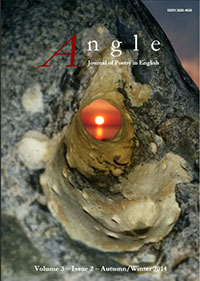 This cover image of the online poetry journal Angle mesmerized me. Though it’s from the Autumn/Winter 2014, Amy Wiseman’s photo, “Sunset Through Hag Stone on Cromer Beach,” warmed me through and has me looking forward to summer.
This cover image of the online poetry journal Angle mesmerized me. Though it’s from the Autumn/Winter 2014, Amy Wiseman’s photo, “Sunset Through Hag Stone on Cromer Beach,” warmed me through and has me looking forward to summer.
 The online Adroit Journal regularly features cool cover art. The last several issues have a “floaty” theme about them. “Whirl” is an award-winning piece by Jedidiah Gist, a freshman at Clemson University.
The online Adroit Journal regularly features cool cover art. The last several issues have a “floaty” theme about them. “Whirl” is an award-winning piece by Jedidiah Gist, a freshman at Clemson University.
Spread the word!
American Life in Poetry :: Kathleen Aguero
American Life in Poetry: Column 517
BY TED KOOSER, U.S. POET LAUREATE
The Dalai Llama has said that dying is just getting a new set of clothes. Here’s an interesting take on what it may be like for the newly departed, casting off their burdens and moving with enthusiasm into the next world. Kathleen Aguero lives in Massachusetts.
Send Off
The dead are having a party without us.
They’ve left our worries behind.
What a bore we’ve become
with our resentment and sorrow,
like former lovers united
for once by our common complaints.
Meanwhile the dead, shedding pilled sweaters,
annoying habits, have become
glamorous Western celebrities
gone off to learn meditation.
We trudge home through snow
to a burst pipe,
broken furnace, looking
up at the sky where we imagine
they journey to wish them bon voyage,
waving till the jet on which they travel
first class is out of sight—
only the code of its vapor trail left behind.
American Life in Poetry is made possible by The Poetry Foundation (www.poetryfoundation.org), publisher of Poetry magazine. It is also supported by the Department of English at the University of Nebraska-Lincoln. Poem copyright ©2013 by Kathleen Aguero from her most recent book of poems, After That, (Tiger Bark Press, 2013). Poem reprinted by permission of Kathleen Aguero and the publisher. Introduction copyright © 2015 by The Poetry Foundation. The introduction’s author, Ted Kooser, served as United States Poet Laureate Consultant in Poetry to the Library of Congress from 2004-2006. We do not accept unsolicited manuscripts.
Spread the word!
SubTerrain Eating Meat & Lush Triumphant
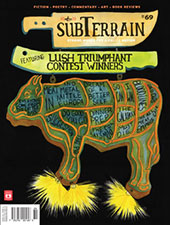 Issue #69 of SubTerrain: Strong Words for a Polite Nation is the result of a call for submissions on the theme of Meat – animal flesh that is eaten for food. Editor Brian Kaufman opens with his editorial “Conflicted, in Carnivore Land,” in which he writes that wading “into the thorny debate on meat consumption” was not intended. Still, he understands there may be just such perceptions with consequences: “While this issue is not intended to be a celebration of meat consumption so much as an exploration into our relationship with meat, we leave ourselves open to the flood of responses from the vegetarians and vegans – please send your letters in!”
Issue #69 of SubTerrain: Strong Words for a Polite Nation is the result of a call for submissions on the theme of Meat – animal flesh that is eaten for food. Editor Brian Kaufman opens with his editorial “Conflicted, in Carnivore Land,” in which he writes that wading “into the thorny debate on meat consumption” was not intended. Still, he understands there may be just such perceptions with consequences: “While this issue is not intended to be a celebration of meat consumption so much as an exploration into our relationship with meat, we leave ourselves open to the flood of responses from the vegetarians and vegans – please send your letters in!”
This issue also includes winning entries from the 2014 Lush Triumphant Literary Awards:
Fiction
Winner: Vickie Weaver (Hagerstown, IN) for “Suggestion”
Poetry
Winner: Matt Whiteman (Vancouver, BC) for “Do Good, You Go”
Creative Non-fiction
Winner: George Ilsley (Vancouver, BC) for “Storytelling”
Spread the word!
Event Non-Fiction 2015 Contest Winners
Event: Poetry and Prose, the Douglas College Review, issue 43.3 features the winners of the 2014 Non-Fiction Contest judged by Deborah Campbell [pictured], author of A Disappearnce in Damascus (August 2015, Knopf Canada).
 “Vocational Rehabilitation” by Hilary Dean
“Vocational Rehabilitation” by Hilary Dean
Scarborough, ON
“Whatever It Is” by Zachary Hug
West Hollywood, CA, USA
“Twenty Miles Above the Limit” by Alessandra Naccarato
Toronto, ON
The other short-listed entries can be found here.
Spread the word!
Segurson on Travel and the Arts
I enjoy reading editor introductions to publications as much as the content itself sometimes. Readers and writers alike can be duly informed of the ‘sensibilities’ of a publication based on what they’ll find in those brief opening notes. In her opening letter to the Fall 2014 Catamaran Literary Reader, Founding Editor Catherine Segurson gives much to inform as well as contemplate:
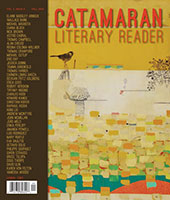 “The freedome to move, to travel and explore, is core to our being. Pulling up roots and heading off to parts unknown frees us from our patterned lives and promotes growth. The journey can be both liberating and terrifying, filled with wonder and potential dangers, every step a lesson about the world and about ourselves – how we deal with the unexpected, how we cope with not knowing what the next turn in the road will bring.”
“The freedome to move, to travel and explore, is core to our being. Pulling up roots and heading off to parts unknown frees us from our patterned lives and promotes growth. The journey can be both liberating and terrifying, filled with wonder and potential dangers, every step a lesson about the world and about ourselves – how we deal with the unexpected, how we cope with not knowing what the next turn in the road will bring.”
. . .
“We don’t have to travel halfway around the world or to distant planets to experience the wonder of what it means to be alive. As long as we are fully aware, even a walk around the block can inspire us; closely studying the structure of a primrose can add to our view of the world. These are lessons we learn from art and litearature as well. Writers, artists, and scientists are in the business of examining life and revealing what they’ve discovered – this, in turn, benefits us as readers and gallery visitors.”
Following these sentiments is much to support Segurson’s perspective, in poetry, fiction, nonfiction, and art (including photography, sculpture, paintings, mixed media, and more – all in full color!). Samples of the artwork and written works published in this issue can be read on the publication’s website.
[Cover art: Candy Tree by Michael Cutlip, 2011, mixed media on panel, 40 x 48 in]
Spread the word!
Malahat Review Contest Winners
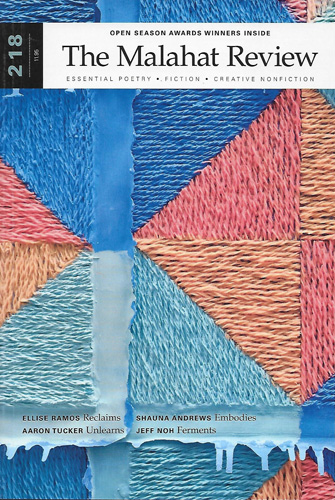 The Malahat Review #189 includes winners of the 2014 Far Horizons Award for Poetry and the 2014 Constance Rooke Creative Nonfiction Prize.
The Malahat Review #189 includes winners of the 2014 Far Horizons Award for Poetry and the 2014 Constance Rooke Creative Nonfiction Prize.
Far Horizons Award for Poetry winner Laura Ritland’s poem “Vincent, in the Dream of Zundert” can be read on the publication’s website, along with an interview with her regarding the award.
“Venn Diagrams” the Constance Rooke Creative Nonfiction Prize winning piece by Rebecca Foust is only available in print, but the website includes an interview with Foust as well.
Spread the word!
Whitefish Review: Encouraging Young Writers
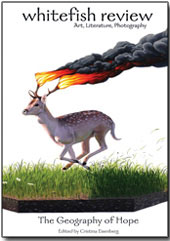 Whitefish Review‘s most recent issue, themed “The Geography of Hope,” includes a feature entitled “Freeflow: Getting into the minds and hearts of Whitefish High School students.” The editors worked with WHS teachers Nikki Reed and Eric Sawtelle to gather students and “gain insight on their sense of place in the mountains and the work they do with Project FREEFLOW (Flathead River Educational Effort for Focused Learning in Our Watersheds).”
Whitefish Review‘s most recent issue, themed “The Geography of Hope,” includes a feature entitled “Freeflow: Getting into the minds and hearts of Whitefish High School students.” The editors worked with WHS teachers Nikki Reed and Eric Sawtelle to gather students and “gain insight on their sense of place in the mountains and the work they do with Project FREEFLOW (Flathead River Educational Effort for Focused Learning in Our Watersheds).”
Coupling literary magazines with young activists to support their work, give them an audience, and create a bond with the printed arts is a great concept other publications could emulate. In addition, while Whitefish Review charges a nominal fee for submissions, there is no charge for writers high school age and younger, encouraging their participation.
This is especially good to know, considering the publication’s latest call for submissions for a themed issue: Mythic Beasts & Monsters. If THAT doesn’t encourage young writers, I don’t know what will!
Until March 15, 2015: “Whitefish Review wants you to dig into supernatural history: Nessie, Sasquatch, and cousin Yeti—the Brontosaurus still rumbling somewhere deep in the Congo’s swamps. Fairies, Trolls, Dragons, Gods ‘n’ Demons. Our own Flathead Lake Monster. What natural models are these beasts based on? What human hopes and fears? Why do we seem to wish that those creatures are really out there? How big and strange is creation anyway — the real pageant of creatures? What about all the bizzarro beasts that are stranger than any legend? (Thank you to Douglas H. Chadwick for the writing prompt.)”
Spread the word!
Books :: Delta Dogs
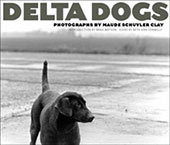 This new book, Delta Dogs from University Press of Mississippi, celebrates the canines who roam this most storied corner of Mississippi. Some of Clay’s photographs feature lone dogs dwarfed by kudzu-choked trees and hidden among the brambles next to plowed fields. In others, dogs travel in amiable packs, trotting toward a shared but mysterious adventure. Her Delta dogs are by turns soulful, eager, wary, resigned, menacing, and contented.
This new book, Delta Dogs from University Press of Mississippi, celebrates the canines who roam this most storied corner of Mississippi. Some of Clay’s photographs feature lone dogs dwarfed by kudzu-choked trees and hidden among the brambles next to plowed fields. In others, dogs travel in amiable packs, trotting toward a shared but mysterious adventure. Her Delta dogs are by turns soulful, eager, wary, resigned, menacing, and contented.
Writers Brad Watson and Beth Ann Fennelly ponder Clay’s dogs and their connections to the Delta, speculating about their role in the drama of everyday life and about their relationships to the humans who share this landscape with them. In a photographer’s afterword, Clay writes about discovering the beauty of her native land from within. She finds that the ubiquitous presence of the Delta dog gives scale, life, and sometimes even whimsy and intent to her Mississippi landscape.
Delta Dogs
By Maude Schuyler Clay
Introduction by Brad Watson
Essay by Beth Ann Fennelly
96 pp. / 10.5 X 9 inches / 70 duotone photographs
[Text from the publisher’s website.]
Spread the word!
Lit Mag Covers :: Picks of the Week
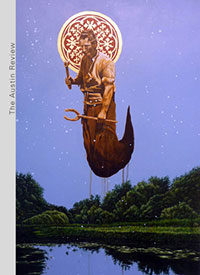
In addition to featuring Pulitzer Prize winning poet James Tate, “captivating fiction and nonfiction,” the cover of The Austin Review issue 3 is equally captivating. “Iron Age” is a work by Austin local Irish artist John Mulvany.
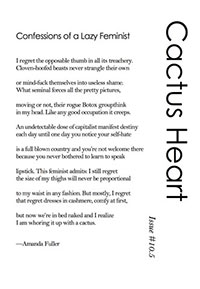
Nope. No stunning imagery here. Instead, I was completely drawn to the cleaver concept of printing one of the publication’s submissions on the front cover. I’ve seen this done on the back cover, but not the front. Cactus Heart #10 is an e-issue, with #10.5 this print version. Featured: “Confessions of a Lazy Feminist” by Amanda Fuller.
Spread the word!
Cincinnati Review: So Much to Recommend!
The most recent issue of Cincinnati Review is unique for a number of reasons. The issue comes with a separately printed, full-color graphic novel, Moth: The Play written by Declan Greene and illustrated by Gabe Ostley. Check out this sweet YouTube video The Making of Moth for a teaser.
The publication also received a grant from the National Endowment for the Arts that allowed the editors to focus on longer forms. “In fiction, this includes several extended stories. In poetry, sequences and long poems lead off each section.” In total, this issue offers almost one hundred additional pages of fiction and poetry.
 And finally, the magazine features a unique partnering of music and poetry. Award-winner composer of chamber works Ellen Ruth Harrison has created music to express three poems by Jakob Stein, originally printed in the Summer 2008 issue. The full score for “Sefiros” appears in this issue along with the reprinted poems and introduction by Poetry Editor Don Bogen. Additionally, the art-song will be performed in the Robert J. Werner Recital Hall at UC’s College-Conservatory of Music on Monday February 16, 2015 at 8 p.m. A podcast of the performance will be posted on the publication’s website following the event.
And finally, the magazine features a unique partnering of music and poetry. Award-winner composer of chamber works Ellen Ruth Harrison has created music to express three poems by Jakob Stein, originally printed in the Summer 2008 issue. The full score for “Sefiros” appears in this issue along with the reprinted poems and introduction by Poetry Editor Don Bogen. Additionally, the art-song will be performed in the Robert J. Werner Recital Hall at UC’s College-Conservatory of Music on Monday February 16, 2015 at 8 p.m. A podcast of the performance will be posted on the publication’s website following the event.
I think that’s quite enough to recommend, don’t you?
Spread the word!
Green Mountains Review – 2014
This issue of Green Mountains Review focuses on different moments, how writers choose to capture those moments, what they bring into those moments, what they take out of those moments, and what these shared moments can provide to the reader. Every piece of work seems to say “This is a moment that has happened or is happening and how, dear reader, will you handle it?” Continue reading “Green Mountains Review – 2014”
Spread the word!
The Antioch Review – Fall 2014
The Fall 2014 issue of The Antioch Review took on the theme of what they have chosen to call “word trucks,” which are similar to “food trucks.” The Antioch Review positions themselves to be like a food truck, “serving up a variety of dishes that were intended to stimulate the intellectual palate with ‘the best words in the best order.’” In order to stimulate the palate of every reader, this issue is packed with essays, poetry, fiction, and reviews, thoughtfully crafted and organized. Continue reading “The Antioch Review – Fall 2014”
Spread the word!
Gigantic Sequins – 2014
Literature is at its best when it resonates, when the reader is inclined to make connections to other texts, genres, and media in an effort to make sense of the work at hand. The resonant quality of the summer issue of Gigantic Sequins is high, indebted to the finely crafted works within its pages. According to Editor-in-chief Kimberly Ann Southwick, “The whole reason we do this thing is to present you some of the finest writers and artists around these days.” In this issue, they have fulfilled this promise. Continue reading “Gigantic Sequins – 2014”
Spread the word!
Left Curve – 2015
For their final print issue, after the recent passing of their editor and publisher, Csaba Polony, Left Curve provides readers with a strong collection of essays, poetry, and a variety of other musings, including a play and an interview with artists Victor and Margarita Tupitsyn. Although the journal will continue to make use of their website, the final hard copy, like Dylan Thomas suggests in his canonized villanelle, does not go gentle into that good night. The selections are designed, written, and selected by thinkers. Continue reading “Left Curve – 2015”
Spread the word!
Ekphrasis – Fall/Winter 2014
Returning to “Girl Eating a Bird” by Vanessa Zimmer-Powell published in this issue of Ekphrasis is becoming a habit. The language haunts as it depicts, surmises as it reveals. In just ten lines, the poem written after viewing Rene Magritte’s painting, Girl Eating a Bird, exposes more of the painting and its subject. The first line “She chewed open cardinal” evokes in iamb, trochee, and dactyl, a nearly cannibalistic gnaw at the bone. In the next line, in the single syllable “raw,” a reader might feel a twinge of sulfuric delight before reading on to the satisfying end. “She won’t stop / until it is well tasted,” and neither will readers. Continue reading “Ekphrasis – Fall/Winter 2014”
Spread the word!
Glimmer Train Stories – Winter 2014
In my admittedly brief career as a reviewer, I’ve not encountered any literary journals that concentrate almost exclusively on the short story. I really like the idea, and obviously so do many other readers. Two differences I noticed about Glimmer Train Stories: this is the only lit mag I’ve read so far that isn’t connected to a college or university; and it’s the only one that includes a bookmarker as a bonus. Continue reading “Glimmer Train Stories – Winter 2014”
Spread the word!
The Antigonish Review – Autumn 2014
I’m honored to review this particular issue of The Antigonish Review because it announces the 2014 poetry and fiction contest winners. I’m glad I wasn’t a judge. It must have been an agonizing process to glean the wheat—the winners—from what couldn’t possibly have been literary chaff. Continue reading “The Antigonish Review – Autumn 2014”
Spread the word!
Main Street Rag – Fall 2014
The Main Street Rag has a different vibe from your distantly intellectual, even-tempered literary journal. It’s unpredictable, quirky. At the very beginning, Publisher/Editor M. Scott Douglass writes in The Front Seat column about why the issue is late and about the kerfuffle of the North Carolina governor inserting himself into the selection of state poet laureate. When he’s had his say on these topics, he directs us to The Back Seat (distinguished by cream-colored pages) toward the end of the issue, where he takes on the U.S. Senate race in North Carolina. This is a hands-on, opinionated rag. Continue reading “Main Street Rag – Fall 2014”
Spread the word!
Enizagam – 2014
If Volume 8 of Enizagam is an accurate measure, age is no indicator of ability. The literary magazine is produced by 9th-12th grade students at the School of Literary Arts at Oakland School for the Arts in Oakland, California. The urban public arts charter school students design, edit, and publish the journal, and they do an excellent job. Enizagam is a beautifully designed read, full of the kind of poetry and fiction that not only delights, but sticks with the reader long after putting the publication down. Continue reading “Enizagam – 2014”
Spread the word!
GreenPrints – Winter 2015
The centennial of anything is generally cause for celebration, but when one is an independent gardening magazine with homegrown roots (pun intended) and a lot of heart, reaching Issue 100 is an even more exciting accomplishment. Issue 100 of GreenPrints does not disappoint. It is a celebration of not only the gardening and gardeners GreenPrints regularly embraces, but also the magazine itself and all those whose impassioned writing is surely on par with their artfully tended begonias and apricot trees. Continue reading “GreenPrints – Winter 2015”
Spread the word!
Eleven Eleven – 2014
Not long after opening Eleven Eleven Issue 17, the reader finds two photographs by Ken Morisawa (“Fishman speed light #4” and “Fishman #18”). The two black and white images ostensibly depict a man diving into dark water, surrounded by chaos and a disturbance of bubbles. One may read this in other ways, but it strikes me as a man diving into the wild, the unknown, a bold and determined move. He may not know what to expect, but he jumps anyway. It is exhilarating. This interpretation fittingly mirrors the experience of opening Eleven Eleven. Continue reading “Eleven Eleven – 2014”
Spread the word!
Burnside Review – Winter 2014
When sitting down to read Burnside Review, I feel you have to be in the right mood: opening to something different with every turn of the page, and craving something that makes you see things in a new way. At my first sit-down, I wasn’t quite prepared, but during my second chance, I got lost in the words, wanting more when I had finished. Continue reading “Burnside Review – Winter 2014”
Spread the word!
Happy Valentine’s Day Poem
American Life in Poetry: Column 516
BY TED KOOSER, U.S. POET LAUREATE
Kurt Brown was a talented poet who died in 2013, and his posthumous selected and new poems opens with this touching late poem to his wife, Laure-Anne.
The Kiss
That kiss I failed to give you.
How can you forgive me?
The kiss I would have spent on you is still
There, within me. It will probably die there.
But it will be the last of me to die.
American Life in Poetry is made possible by The Poetry Foundation (www.poetryfoundation.org), publisher of Poetry magazine. It is also supported by the Department of English at the University of Nebraska-Lincoln. Poem copyright © 2014 by the Estate of Kurt Brown, “The Kiss,” from I’ve Come This Far to Say Hello: Poems Selected and New by Kurt Brown (Tiger Bark Press, 2014). Poem reprinted by permission of The Estate of Kurt Brown and Tiger Bark Press. Introduction copyright © 2015 by The Poetry Foundation. The introduction’s author, Ted Kooser, served as United States Poet Laureate Consultant in Poetry to the Library of Congress from 2004-2006. We do not accept unsolicited manuscripts.
Spread the word!
Freedom to Read Week Canada
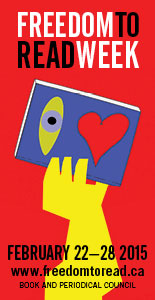 February 22-28, 2015 is Freedom to Read Week, an annual event that encourages Canadians to think about and reaffirm their commitment to intellectual freedom, which is guaranteed them under the Charter of Rights and Freedoms.
February 22-28, 2015 is Freedom to Read Week, an annual event that encourages Canadians to think about and reaffirm their commitment to intellectual freedom, which is guaranteed them under the Charter of Rights and Freedoms.
Freedom to Read Week encourages Canadians to focus on issues of intellectual freedom as they affect community, your province, country, and countries around the world. Whether a librarian, bookseller, educator, student, or member of the community, there are lots of ways you can help mark this annual event.
Each year, the Freedom to Read Kit includes a “Get Involved” section that provides activities designed for classroom instruction and discussion. “Get Involved” is also intended for citizens outside the classroom who wish to plan community events, and the organization’s website includes a number of ideas and resources as well.
Freedom to Read Week is organized by the Freedom of Expression Committee of the Book and Periodical Council.
Spread the word!
Special Issue :: New York School and Diaspora
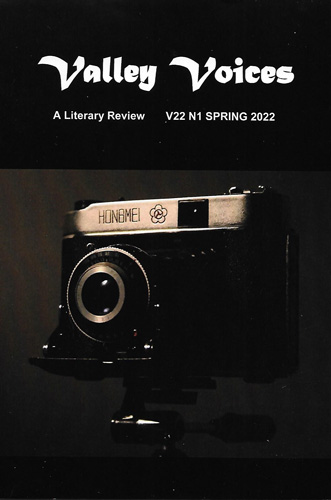 The newest issue of Valley Voices (Fall 2014, published by Mississippi Valley State University) is a special issue focused on New York School and Diaspora. Guest Editor Angela Ball writes in her introduction that she hosted a symposium on New York School Poetry and the South and extended the conversation of that gathering with this special issue, including the works of former U.S. Poet Laureate Billy Collins, Denise Duhamel, Barbara Hamby, David Kirby, and David Lehman, who had originally attended the symposium.
The newest issue of Valley Voices (Fall 2014, published by Mississippi Valley State University) is a special issue focused on New York School and Diaspora. Guest Editor Angela Ball writes in her introduction that she hosted a symposium on New York School Poetry and the South and extended the conversation of that gathering with this special issue, including the works of former U.S. Poet Laureate Billy Collins, Denise Duhamel, Barbara Hamby, David Kirby, and David Lehman, who had originally attended the symposium.
David Lehman agreed to join the project as Associate Editor, suggesting Angela Ball include blog entries she had written for Best American Poetry discussing the “big four poets of the New York School”: Frank O’Hara, Kenneth Koch, John Ashbery, and James Schuyler.
Also included in the issue are student essays and comments written as part of a seminar Ball was teaching at the time, “The Poetry of the New York School.” Ball writes that these “record what graduate students in poetry writing, fiction writing, and literature have to say about the special qualities of the New York School that make it a potent force for leavening and enlivening contemporary poetry in the South and elsewhere.”
Spread the word!
Women and the Global Imagination
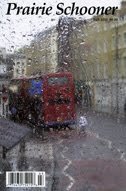 Prairie Schooner Winter 2014 includes a generous poetry portfolio edited by Alicia Suskin Ostriker: Women and the Global Imagination. In her preface, Ostriker writes:
Prairie Schooner Winter 2014 includes a generous poetry portfolio edited by Alicia Suskin Ostriker: Women and the Global Imagination. In her preface, Ostriker writes:
“‘Imagination’ is a key word here. . . There is an amazing fullness of poetic imagination in these pages. The poets imagine their ancestors going back to ‘the first cave,’ as Venus Khoury-Ghata says, or to their immediate parents. They imagine freedom, and the struggle for freedom. They inventory the body and its appetites. They tell stories. They speak in the voices of invented or historical characters. . . There is no narrowly defined female aesthetic here. The poems are lyric, satiric, mythic, experimental, surreal, expansive, laconic, conversational, tender, angry, allegorical, oracular.”
Authors included in the portfolio: Judith Vollmer, Diana Garcia, Aliki Barnstone, Margo Berdeshevsky, Karen Alkalay-Gut, Dahlia Ravikovitch, Fiona Sze-Lorrain, Cynthia Hogue, Katie Bickham, Veronica Golos, Ann Fisher-Wirth, Anne Germanacos, Vénus Khoury-Ghata, Ladan Osman, Nathalie Handal, Rebecca Gayle Howell, Lorraine Healy, Ursula K. Le Guin, Naoko Fujimoto, Marilyn Krysl, Olga Sedakova, Tsitsi Jaji, Adélia Prado, Jeannie Vanasco, Judith H. Montgomery, Martha Collins, Liliana Ursu, Karthika Naïr, Batsirai E. Chigama, Suzanne Gardinier, Maria Kelson, and Eleanor Wilner.
Spread the word!
Iowa Review Tim McGinnis Award Winner
 Dinika M. Amaral, winner of the Iowa Review Tim McGinnis Award, has her story featured in the newest issue as well as online, along with a YouTube video of her reading and excerpt from the story. “No Good Deed Unpunished” is described by the editor as “a Hinglish tale of schoolgirl misadventures, comic and otherwise” and as providing “an ideal example of the sort of quirky creativity the McGinnis Award is meant to celebrate.”
Dinika M. Amaral, winner of the Iowa Review Tim McGinnis Award, has her story featured in the newest issue as well as online, along with a YouTube video of her reading and excerpt from the story. “No Good Deed Unpunished” is described by the editor as “a Hinglish tale of schoolgirl misadventures, comic and otherwise” and as providing “an ideal example of the sort of quirky creativity the McGinnis Award is meant to celebrate.”
At the end of each year, The Iowa Review editor and staff choose, from all the work published in their pages over the previous year, a piece that they think most fits the comic spirit of one-time contributor Tim McGinnis. The award comes with a $1000 prize.
Spread the word!
What’s New KENYON Review?
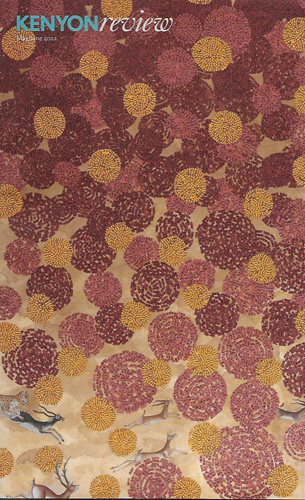 It was the change in format that first caught my eye with the new KENYON Review. Editor David H. Lynn comments on this altered physical appearance, but also a great deal more about how he and the staff and editors at Kenyon Review looked at the changing landscape of its readers to update the publication:
It was the change in format that first caught my eye with the new KENYON Review. Editor David H. Lynn comments on this altered physical appearance, but also a great deal more about how he and the staff and editors at Kenyon Review looked at the changing landscape of its readers to update the publication:
“I am delighted to present this first issue of a new volume year and with it the boldest revisions of design and frequency in the seventy-five-year trajectory of the Kenyon Review. Even that last ‘the’ has been challenged. More on that later. But note, please, that not only the look and feel of our magazine are dramatically new. It will now appear every two months, six times a year, rather than the quarterly iterations of many decades. All of this comes after two years of questions and debate and planning.”
Read Lynn’s full commentary here (and how he got cheeky with the “the”).
Spread the word!
Lit Mag Covers :: Picks of the Week
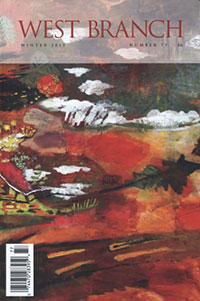
Still in the bleak of Michigan winter, I’m going for color first this week. West Branch Winter 2015 features Wetlands at Dawn by Sophia Heymans (2012, acrylic, papter mache, oil on board).
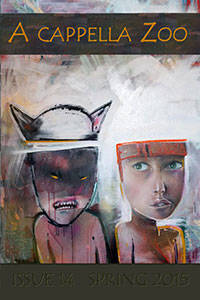
Inappropriate Fear, mixed paints on canvas by Julian Kimmings is the feature image on the cover of A cappella Zoo. “Fear makes the wolf look bigger,” is the accompanying text, appropriate perhaps for this publication of magic realism and slipstream stories.
